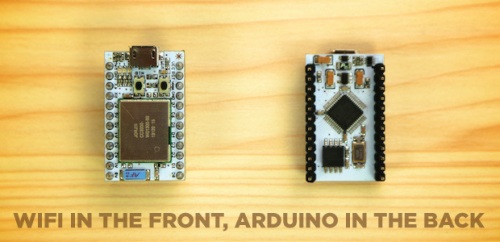The Spark Core makes adding Wi-Fi to DIY projects devilishly easy; the device sets up in seconds and can be programmed wirelessly. Traditional solutions are expensive and difficult to work with, requiring a specific Arduino shield often the size of the Arduino itself, and updating the code necessitates a micro USB connected to a local computer. With the Spark Core, you can finally feel like you're living in the 21st century as all this can be done wirelessly.
The device combines the simplicity of an Arduino with the power of an ARM Cortex M3 chip, the best Wi-Fi module available (CC3000), cloud computing, and a REST API to create a flexible development that integrates the Internet into your projects. The Spark can be used to craft solar-powered wireless cameras, Wi-Fi controlled RC cars, wireless motion detectors, or whatever your imagination conjures up.

The Spark Core is Wi-Fi enabled within 30 seconds.
Connecting the Wi-Fi
Setting up the Wi-Fi is extremely simple thanks to the Smart Config feature of the CC3000 module; all that’s required is entering the network name and password into the Spark app on your smart phone or tablet, and within 30 seconds the Core is connected. It’s a one-time process.
This simplicity is unheard of with Wi-Fi modules and unique to the Spark Core. Multiple steps are typically required to configure a device onto a network, such as jumping between permanent and ad hoc Wi-Fi networks.
Programming
The Spark Core is programmed using Wiring, the scripting language shared with the entire Arduino platform. No USB cables are necessary; simply put on sunglasses, park yourself in a comfortable chair, and upload the code you’ve written using the text editor of your choice. The firmware is updated wirelessly, and can be reprogramed at any given time as soon the Wi-Fi is set up for easy maintenance.
Open Source
All firmware and hardware design files will be open source, permitting free integration into any derivative projects. Additionally, the Spark Core uses open standards such as HTTP, TCP, TLS/SSL, and protocol buffers for communications.
Spark Cloud
All the source codes you've written for various projects are stored within a cloud network called the Spark Cloud. These codes are accessible anywhere in the world to either you or an authorized user so long as there's an internet connection. Whenever you wish to update the firmware of one of your projects, it is downloaded directly into the device from the Spark Cloud.
Encryption
A 128-bit industry-standard encryption is used to secure the Spark Core, Spark Cloud, and the entire development platform, specifically AES encryption for the hardware side and SSL for securing the wireless transmissions.
Shields
Four shields, or completed circuits, are to extend functionality beyond the initial configuration of the Spark Core.
• The Shield shield converts the footprint and pins of the Spark Core to that of an Arduino to allow usage of all Arduino-specific shields.
• The Relay Shield can be used to control outlet or high-voltage electronics wirelessly; you can turn your lights on with a remote control.
• The JTAG shield enables the code to be directly flashed onto the microcontroller present on the Spark Core.
• The Battery Shield simply adds more power to your project.
The Spark Core’s Kickstarter campaign launched on May 2 and has overtaken its crowd-funding goal by 1,948%. To find all the latest updates, visit the Spark Core’s Kickstarter page.
Advertisement
Learn more about Electronic Products Magazine





